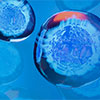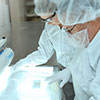BIOTIUM, INC
Catalog Number:
(75975-956)
Supplier:
Biotium
Description:
TAG-72 / CA72.4, Monoclonal antibody, Clone: CA72/733, Host: Mouse, Species reactivity: Human, Hamster, Dog, Cow, Rat, Isotype: IgG1, kappa, BSA-free, Immunogen: Membrane-enriched fraction of a human breast, Synonym: CA72.4, Size: 50 uL
Supplier:
Biotium
Description:
CD14 Monoclonal antibody, Clone: LPSR/654, Host: Mouse, Species reactivity: Human, Isotype: IgG's, Conjugate: CF568, Immunogen: Recom human LPSR protein, Synonyms: LPS-R, LPSR, Mo2, Application: Immunofluorescence, Flow cytometry, Size: 500 uL
Supplier:
Biotium
Description:
Twenty human keratins are resolved with two-dimensional gel electrophoresis into acidic (pI 6.0) subfamilies. This antibody cocktail recognizes acidic (Type I or LMW) and basic (Type II or HMW) cytokeratins, which 67 kDa (CK1); 64 kDa (CK3); 59 kDa (CK4); 58 kDa (CK5); 56 kDa (CK6); 52 kDa (CK8); 56.5 kDa (CK10); 50 kDa (CK14); 50 kDa (CK15); 48 kDa (CK16); 40 kDa (CK19). Many studies have shown the usefulness of keratins as markers in cancer research and tumor diagnosis. AE-1/AE-3 is a broad spectrum anti pan-cytokeratin antibody cocktail, which differentiates epithelial tumors from non-epithelial tumors e.g. squamous vs. adenocarcinoma of the lung, liver carcinoma, breast cancer, and esophageal cancer. It has been used to characterize the source of various neoplasms and to study the distribution of cytokeratin containing cells in epithelia during normal development and during the development of epithelial neoplasms. This antibody stains cytokeratins present in normal and abnormal human tissues and has shown high sensitivity in the recognition of epithelial cells and carcinomas.
Supplier:
Biotium
Description:
CD68 Monoclonal antibody, Clone: LAMP4/824, Host: Mouse, Species reactivity: Human, Isotype: IgG2a, kappa, Conjugate: biotin, Immunogen: Recom human LAMP4 protein, Synonyms: GP110, LAMP4, Application: IF, IHC, FC, Size: 500 uL
Supplier:
Biotium
Description:
This antibody reacts with human CD59, a 20 kDa glycosyl phosphatidyl-inositol (GPI)-anchored cell surface protein. CD59 regulates complement-mediated cell lysis, and it is involved in lymphocyte signal transduction. This protein is a potent inhibitor of the complement membrane attack complex, whereby it binds complement C8 and/or C9 during the assembly of this complex, thereby inhibiting the incorporation of multiple copies of C9 into the complex, which is necessary for osmolytic pore formation. It inhibits formation of MAC, thus protecting cells from complement-mediated lysis. Genetic defects in GPI-anchor attachment, that cause a reduction or loss of CD59 and CD55 on erythrocytes produce the symptoms of the disease paroxysmal hemoglobinuria (PNH). This MAb is useful for study on GPI-anchored proteins, PNH and CD59 functions. CD59 is widely distributed on cells in all tissues. The expression of CD59 on erythrocytes is important for their survival.
CF® dyes are Biotium's next-generation fluorescent dyes. CF®594 is a deep red fluorescent dye (Ex/Em 593/614 nm). It yields the brightest conjugates among spectrally similar dyes, and has excellent photostability.
Supplier:
Biotium
Description:
This antibody recognizes a protein of 40 kDa, identified as Thyroid transcription factor-1 (TTF-1). TTF-1 is a member of the NKx2 family of homeodomain transcription factors. It is expressed in epithelial cells of the thyroid gland and the lung. Nuclei from liver, stomach, pancreas, small intestine, colon, kidney, breast, skin, testes, pituitary, prostate, and adrenal glands are unreactive. Anti-TTF-1 is useful in differentiating primary adenocarcinoma of the lung from metastatic carcinomas originating in the breast, mediastinal germ cell tumors, and malignant mesothelioma. It can also be used to differentiate small cell lung carcinoma from lymphoid infiltrates.Loss of TTF-1 expression in non-small cell lung carcinoma has been associated with aggressive behavior of such neoplasms. TTF-1 reactivity is also seen in thyroid malignancies.
CF® dyes are Biotium's next-generation fluorescent dyes. CF®568 is a red fluorescent dye (Ex/Em 562/583 nm) with superior brightness and photostability. It also is compatible with super-resolution imaging by STORM and TIRF.
Supplier:
Biotium
Description:
Chromogranin A is present in neuroendocrine cells throughout the body, including the neuroendocrine cells of the large and small intestine, adrenal medulla and pancreatic islets. It is an excellent marker for carcinoid tumors, pheochromocytomas, paragangliomas, and other neuroendocrine tumors. Co-expression of chromogranin A and neuron specific enolase (NSE) is common in neuroendocrine neoplasms. Reportedly, co-expression of certain keratins and chromogranin indicates neuroendocrine lineage. The presence of strong anti-chromogranin staining and absence of anti-keratin staining should raise the possibility of paraganglioma. The co-expression of chromogranin and NSE is typical of neuroendocrine neoplasms. Most pituitary adenomas and prolactinomas readily express chromogranin.
CF® dyes are Biotium's next-generation fluorescent dyes. CF®647 is a far-red fluorescent dye (Ex/Em 650/665 nm) with excellent brightness. It also is compatible with super-resolution imaging by STORM.
Supplier:
Biotium
Description:
TAG-72 / CA72.4, Monoclonal antibody, Clone: CC49, Host: Mouse, Species reactivity: Human, Hamster, Dog, Cow, Rat, Isotype: IgG1, kappa, Conjugate: CF405S, Immunogen: Membrane-enriched fraction of breast carcinoma, Synonyms: CA72.4, Size: 100uL
Supplier:
Biotium
Description:
This antibody recognizes a 60 kDa protein, identified as the heat shock protein 60 (hsp60). A wide variety of environmental and pathophysiological stressful conditions trigger the synthesis of a family of proteins known as heat shock proteins (HSPs), more appropriately called as stress response proteins (SRPs). Hsp60 is a potential antigen in a number of autoimmune diseases. In human arthritis and in experimentally induced arthritis in animals, disease development coincides with the development of immune reactivity directed against not only bacterial hsp60, but also against its mammalian homolog.
CF® dyes are Biotium's next-generation fluorescent dyes. CF®405S is a blue fluorescent dye (Ex/Em 404/431 nm) with superior brightness compared to other blue dyes; it is also compatible with super-resolution imaging by SIM. Note: Conjugates of blue fluorescent dyes are not recommended for detecting low abundance targets, because blue dyes have lower fluorescence and can give higher non-specific background than other dye colors.
Supplier:
Biotium
Description:
Goat anti-mouse IgG2b is an affinity-purified antibody that reacts with Fc portion of the heavy chain of mouse IgG2b. To minimize cross reactivity, the antibody is cross-adsorbed against other mouse IgG subclasses (IgG1, IgG2a, IgG3), and human, bovine and rabbit serum proteins. CF™405S is a blue fluorescent dye with an absorption peak wavelength that nearly coincides with the 405 nm blue diode laser line. In addition, the emission peak wavelength of the dye well centers within the blue detection window of BD flow cytometers. As a result, flow cytometry analysis using CF™405S results in much brighter signal compared to Alexa Fluor® 405.
Alexa Fluor® is a registered trademark of Thermo Fisher Scientific.
Catalog Number:
(89493-096)
Supplier:
Biotium
Description:
Anti-IgG Goat Polyclonal Antibody (CF™ 555)
Supplier:
Biotium
Description:
This antibody recognizes a protein of 40 kDa, identified as CD7, a member of the immunoglobulin gene superfamily. Its N-terminal amino acids 1-107 are highly homologous to Ig kappa-L chains whereas the carboxyl-terminal region of the extracellular domain is proline-rich and has been postulated to form a stalk from which the Ig domain projects. CD7 is expressed on the majority of immature and mature T-lymphocytes, and T cell leukemia. It is also found on natural killer cells, a small subpopulation of normal B cells and on malignant B cells. Cross-linking surface CD7 positively modulates T cell and NK cell activity as measured by calcium fluxes, expression of adhesion molecules, cytokine secretion and proliferation. CD7 associates directly with phosphoinositol 3'-kinase. CD7 ligation induces production of D-3 phosphoinositides and tyrosine phosphorylation.
Supplier:
Biotium
Description:
Anti-IgG Donkey Polyclonal Antibody (CF™ 640R)
Supplier:
Biotium
Description:
CD5 Monoclonal antibody, Clone: CD5/54/F6, Host: Mouse, Species reactivity: Rabbit, Horse, Monkey, Pig, Cow, Rat, Human, Guinea Pig, Chicken, Isotype: IgG's, Conjugate: CF568, Immunogen: peptide, Synonyms: CD5 antigen (p56 62), LEU1, Application: IF, Size: 100uL
Supplier:
Biotium
Description:
CD45RB Monoclonal antibody, Clone: PTPRC/1132, Host: Mouse, Species reactivity: Human, Isotype: IgG1, kappa, Conjugate: CF488A, Immunogen: Recom full-length human CD45RB protein, Synonyms: B220, CD45R, Application: IF, IHC, WB, FC, Size: 100uL
Catalog Number:
(75881-790)
Supplier:
Biotium
Description:
This antibody recognizes a protein of 110 kDa, which is identified as androgen receptor (AR). It reacts with full length, and the newly described A form of the receptor. It does not cross react with estrogen, progesterone, or glucocorticoid receptors. The expression of AR is reportedly inversely correlated with histologic grade i.e. well differentiated prostate tumors show higher expression than the poorly differentiated tumors. In prostate cancer, AR has been proposed, as a marker of hormone-responsiveness and thus it may be useful in identifying patients likely to benefit from anti-androgen therapy. Anti-androgen receptor has been useful clinically in differentiating morpheaform basal cell carcinoma (mBCC) from desmoplastic trichoepithelioma (DTE) in the skin.This MAb is superb for staining of formalin/paraffin tissues.
Inquire for Price
Stock for this item is limited, but may be available in a warehouse close to you. Please make sure that you are logged in to the site so that available stock can be displayed. If the
Stock for this item is limited, but may be available in a warehouse close to you. Please make sure that you are logged in to the site so that available stock can be displayed. If the
You must log in to order restricted items. We request that you provide the required business documentation to purchase this product for the first time.
To order chemicals, medical devices, or other restricted products please provide identification that includes your business name and shipping address via email CMD_NA@vwr.com or fax 484.881.5997 referencing your VWR account number . Acceptable forms of identification are:
-Additional Documentation May be needed to purchase this item. A VWR representative will contact you if needed.
This product has been blocked by your organization. Please contact your purchasing department for more information.
The original product is no longer available. The replacement shown is available.
This product is currently unavailable but limited stock may be available in our extended warehouse network. Please call 1-800-932-5000 and a VWR Customer Service Representative will help you.
|
|||||||||


































